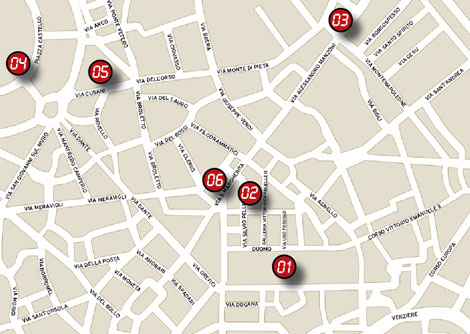Sara Turner discovers sky-high sunbathing spots, strange rituals and luscious ice cream in the city of style

1. Duomo
The duomo is one of Milan’s most iconic sights – resembling a white-quilled porcupine, the cathedral’s elaborate marble façade dominates the piazza. (If you see any screaming teenagers on the square, don’t worry, as they’re just trying to get on TV – the popular TRL music programme is filmed in one of the buildings overlooking it.) Construction of the duomo started in 1386, but it wasn’t until Napoleon Bonaparte invaded Italy that the façade was finished – he was crowned King of Italy here on May 26, 1805, a title he would retain for only nine years until the Austrians took power.
It’s free to enter so have a wander around inside and check out the soaring columns and delicate stained glass. To really appreciate the fine sculpted marble, head up to the roof, where in the summer you’ll find people sunbathing. You can walk up, with entry to the rooftop costing e5, but there are hundreds of steps so you might be better off paying for the lift (e8). Visit duomomilano.it
2. Galleria Vittorio Emanuele II
A shopping mall like no other, Galleria Vittorio Emanuele II was named after the first king of unified Italy, which unlike Napoleon’s smaller kingdom included Sicily, Sardinia, Rome and Turin and was not answerable to the French. Linking Piazza del Duomo and Piazza della Scala, home of La Scala opera house, it is one of the oldest malls in the world and is home to Prada’s oldest boutique, dating from 1913. You’ll also find Gucci, Louis Vuitton and the charming Borsalino hat store.
The floor of the Galleria is a mosaic depicting the symbols of the four main cities of unified Italy – Turin (the bull), Milan (the white shield with a red cross), Florence (a fleur-de-lys) and Rome (Romulus and Remus). At the Turin part, you might see visitors turning on the spot for no apparent reason. Look closely and you’ll see that they spin three times on the bull’s testicles, now fairly worn out, for good luck.
3. The fashion quarter
Wander along Corso Vittorio Emanuele and turn left on to Via Montenapoleone, the heart of the fashion quarter. As a world design capital, Milan’s shopping is near impossible to beat, especially during the sales, usually held in January and July, when you can pick up some quality booty at bargain prices. To the Milanesi, fashion is art, and few hip young things will be seen on the street without the latest designer jeans, shoes, scarves and the ubiquitous “it” bag. At the top of Via Montenapoleone, Spazio Armani is a good place for a browse, stocking everything from women’s and men’s clothes to flowers, handbags and jewellery. Pay a visit to the homeware section in the basement and admire the super-sleek furniture on display.
4. Castello Sforzesco
Walk along Via Monte di Pieta and continue until you reach Milan’s austere castle. Castello Sforzesco originally dates from the 14th century, although the current structure was built the century after under Francesco Sforza, rumoured to have been able to bend metal bars with his bare hands.
The castle not only serves as a vivid reminder of the city’s many battles, but it is also home to several museums and galleries. The Pinacoteca’s extensive art collection includes masterpieces by Mantegna, Canaletto and Cerano, while the charming Museum of Musical Instruments is also worth a visit, as are the Egyptian and Prehistoric sections of the Archaeological Museum. The castle is free to enter and is open daily from 7am to 6pm (until 7pm in summer), while the museums are open 9am-5.30pm daily (except Mon) and cost e7 for a three-day pass for all of them, or from e3 each. Visit milanocastello.it
5. Catch a tram
If you have time, and if the weather is on your side, take a walk through the green and vibrant Parco Sempione behind the castle before heading back to Via Cusani at the front. From here you can catch one of the city’s historic trams, some of which have been running for more than 70 years and still have their original varnished wood interiors. Jump on a number one, which will take you through the old city streets up to Settembrini Vitruvio near Stazione Centrale in Piazza Duca d’Aosta – have a look inside the station at the grandiose mix of art nouveau and art deco design. Trams, like buses, cost e1 – tickets must be bought beforehand and validated on board, and you can travel for 75 minutes per ticket. They can be bought from machines on the street or authorised retailers – look out for a “T” sign above the door of bars and tobacco shops. Visit atm-mi.it
6. Heaven is a Gelato
Jump on a tram back to the city centre and give in to a little ice cream indulgence. The art of gelato lives on in Italy, with some afternoon sweetness a regular pass-time for locals and tourists alike. Among the best is Grom at 16 Via Santa Margherita, a small chain that started in Turin in 2003. Its sorbets are made with Lurisia mountain water, while for the ice creams only whole milk, organic eggs and the best cocoas and coffees from central America are used. The company has also recently bought a farm so it can cultivate its own ingredients. Visit grom.it
If it’s past the watershed and you’re looking for something stronger, there are plenty of bars that offer aperitivo refreshments, perfect for the end of a long day – see this month’s issue of Business Traveller for an article on the art of aperitivo in Milan.








